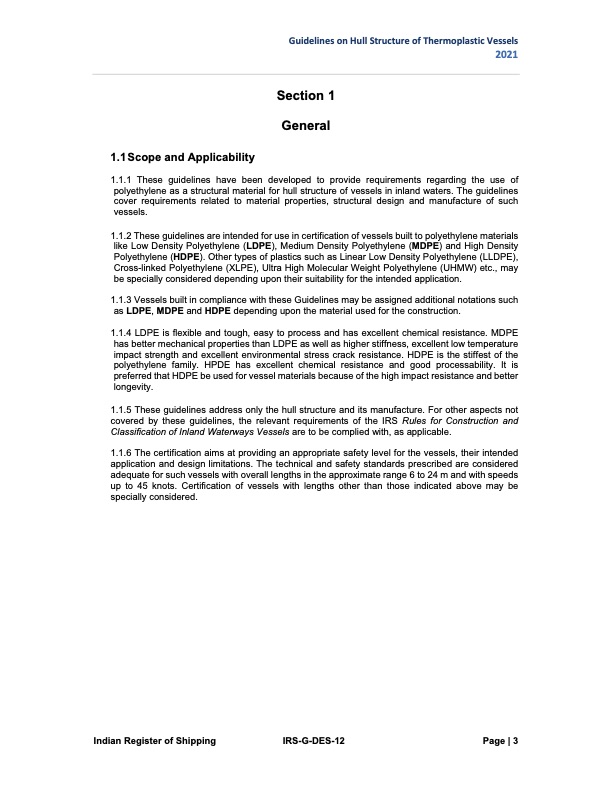
PDF Publication Title:
Text from PDF Page: 003
Guidelines on Hull Structure of Thermoplastic Vessels 2021 Section 1 General 1.1.1 These guidelines have been developed to provide requirements regarding the use of polyethylene as a structural material for hull structure of vessels in inland waters. The guidelines cover requirements related to material properties, structural design and manufacture of such vessels. 1.1.2 These guidelines are intended for use in certification of vessels built to polyethylene materials like Low Density Polyethylene (LDPE), Medium Density Polyethylene (MDPE) and High Density Polyethylene (HDPE). Other types of plastics such as Linear Low Density Polyethylene (LLDPE), Cross-linked Polyethylene (XLPE), Ultra High Molecular Weight Polyethylene (UHMW) etc., may be specially considered depending upon their suitability for the intended application. 1.1.3 Vessels built in compliance with these Guidelines may be assigned additional notations such as LDPE, MDPE and HDPE depending upon the material used for the construction. 1.1.4 LDPE is flexible and tough, easy to process and has excellent chemical resistance. MDPE has better mechanical properties than LDPE as well as higher stiffness, excellent low temperature impact strength and excellent environmental stress crack resistance. HDPE is the stiffest of the polyethylene family. HPDE has excellent chemical resistance and good processability. It is preferred that HDPE be used for vessel materials because of the high impact resistance and better longevity. 1.1.5 These guidelines address only the hull structure and its manufacture. For other aspects not covered by these guidelines, the relevant requirements of the IRS Rules for Construction and Classification of Inland Waterways Vessels are to be complied with, as applicable. 1.1.6 The certification aims at providing an appropriate safety level for the vessels, their intended application and design limitations. The technical and safety standards prescribed are considered adequate for such vessels with overall lengths in the approximate range 6 to 24 m and with speeds up to 45 knots. Certification of vessels with lengths other than those indicated above may be specially considered. 1.1Scope and Applicability Indian Register of Shipping IRS-G-DES-12 Page | 3PDF Image | Hull Structure of Thermoplastic Vessels 2021

PDF Search Title:
Hull Structure of Thermoplastic Vessels 2021Original File Name Searched:
guidelines-on-thermoplastic-boats.pdfDIY PDF Search: Google It | Yahoo | Bing
Development of a solar powered Electric Ship The Electricship website originally started off as a project to develop a comprehensive renewable, affordable, modular electric ship... More Info
Modular Boat Hull Composite The case for a unsinkable, modular composite hybrid boat hull... More Info
MS Burgenstock Hybrid Electric Catamaran Lake Lucerne Unique shuttle servicing Lucerne to the Burgenstock Resort... More Info
Ground Power Unit GPU Powered by Lithium Ion Batteries The goal of the Ground Power Unit is to provide a readily accessible, modular, ready-to-power solution for remote power... More Info
| CONTACT TEL: 608-238-6001 Email: greg@electricship.com | RSS | AMP |